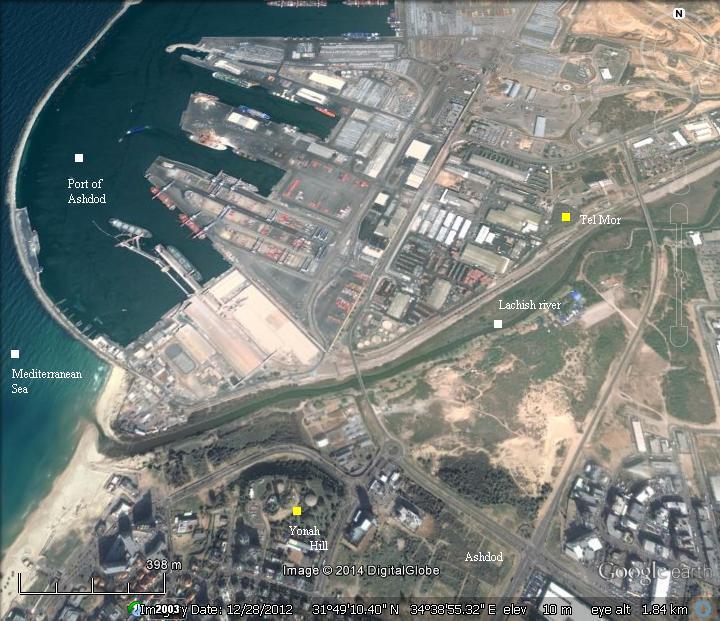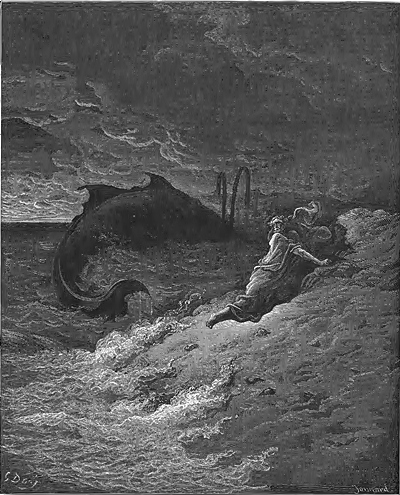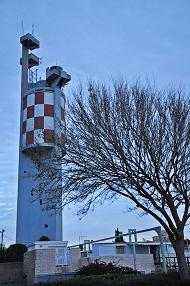An archaeological mound and the traditional tomb of Jonah, situated on a hill overlooking the mouth of the Lachish river.
Home > Sites > Shefela > Ashdod > Yonah Hill, Mitzpeh Yonah
Contents:
Background
Location
History
Photos
* Park
* Lighthouse
* Views
* Tomb of Jonah
Etymology
Links
Overview:
Yonah (Jonah) hill is located on the north-west side of Ashdod, overlooking the mouth of the Lachish river and the port of Ashdod. On this hill, 53m above sea level, is the traditional tomb of Jonah, and excavations unearthed ruins of a First Temple period fortified observation post from the times of Jonah.
Location and Map:
An aerial view of the area around Yonah hill is shown here, with indication of the major sites.

History:
Yonah Hill (Nebi Yunis) and Tel Mor (Tell el Murreh) are two ancient mounds on both sides of Nahal Lachish. Both were settled in the ancient times: Yonah hill in the first Millennium BC and Tel Mor in the second Millennium BC.
- Jonah the prophet (8th century BC)
Jonah, the son of Amittai, was a prophet during the First Temple period. He was commanded to carry the words of the Lord in the Assyrian capital city of Nineveh, but refused and tried to escape from Jaffa to Tarshish (Jonah 1 3):
“But Jonah rose up to flee unto Tarshish from the presence of the LORD, and went down to Joppa; and he found a ship going to Tarshish: so he paid the fare thereof, and went down into it, to go with them unto Tarshish from the presence of the LORD”.
A great storm threatened the safety of the ship, and the mariners threw him overboard, an he was swallowed by a whale (1 19):
“And Jonah was in the belly of the fish three days and three nights”. Eventually, Jonah agreed to do as commanded by the Lord, so he was “vomited out upon dry land”, and then went to Nineveh to complete the mission.

Jonah cast overboard to the whale – by Gustav Dore (French artist, 1832-1883)
On the hill were remains of a Muslim cemetery. A Muslim tradition shows the tomb of Jonah in a Sheikh’s tomb on the western side of the hill, but it was destroyed in 1961.
The tradition of the location of the tomb of Jonah, or the belief the site was the landing place of Jonah after he was spitted out from the whale, was adapted by Christians and Jews. The sanctuary of Jonah appears in the Madaba Map – an ancient mosaic map of the Holy Land from the 6th C AD, which was discovered in 1884 in a Byzantine church in Madaba, Jordan. The Greek inscription reads: “Saint Jonah”. The icon shows a memorial building with a orange/red dome, flanked by two towers. In the sea below may be a section of the whale.
Part of Madaba map
Tomb of Jonah in Ninveh:
The Tomb of Jonah, also known as the Shrine of Prophet Jonah, is a holy site located in the city of Mosul, Iraq. It is believed to be the burial place of the Prophet Jonah, who is revered as a prophet by Jews, Christians, and Muslims. According to the biblical account, Jonah was sent by God to preach to the people of Nineveh, which is located in present-day Mosul. The shrine is located on an ancient mound called Nebi Yunus, which is Arabic for “the Prophet Jonah.”
The shrine has been a site of pilgrimage for centuries, and it was an important religious site for the local Christian community until recent years. However, in 2014, the tomb was destroyed by the Islamic State of Iraq and the Levant (ISIL) during their occupation of Mosul. Since then, efforts have been made to rebuild the shrine, but as of my knowledge cutoff of September 2021, the reconstruction efforts were still ongoing.
-
Ottoman period (16th – 20th century)
Survey of Western Palestine :
Conder and Kitchener of the Palestine Exploration Fund (PEF) surveyed the area during the Survey of Western Palestine (SWP) in 1874-75.
Their map shows the location of Neby Yunis (“Prophet Jonah”), on the south bank of Lachish river (Nahr Sukereir).
Part of map Sheet 16 of Survey of Western Palestine,
by Conder and Kitchener, 1872-1877.
(Published 1880, reprinted by LifeintheHolyLand.com)
Other sites are marked on the map:
-
- Esdud – To the south of the site were the ruins of Tel Ashdod.
- Via Maris – Sea way – this ancient highway is marked as a double line, connecting the empires on the North to Egypt on the South. It crossed the river at Jisr Esdud (bridge of Ashdod).
- Tell el Murreh – Across the river is this mound, now named Tel Mor, where the Canaanite/Philistine port was once located. The Arabic translation (per PEF name lists, p. 275) is: “The mound of the brackish water, but perhaps named from the Beni Murreh Arabs”.
- Tell Akhdar – Arabic: the green mound. This is another name of Tel Mor, although it is marked apart of Tell Mureh.
- Buaik Abu Sueileh – the cattle sheds of Abu Sueileh
- Archaeological surveys and excavations
Prior to the construction of the lighthouse in 1960, a probe was conducted. Four levels were identified: Architectural remains of the Iron Age II period, an Aramaic Ostracon dated to the Persian period, Hellenistic period ceramics, and Muslim tombs.
The survey of the Ashdod map (#84), conducted in the 1980s and published in the Archaeological survey of Israel (map #84, site 19), dated the ceramics to Late Bronze, Iron Age II, Persian, Hellenistic, Early and Late Roman, Byzantine, Early Islamic and Mameluke (including a 14th C silver coin). A Muslim cemetery and architectural remains were reported by the survey.
In 2012 a salvage excavation was conducted here on the western slope. Four archaeological levels were identified, including massive foundations of a building dated to the late 8th century BC, which served as a fortified observation post. This finding suggests that the site was strategically important during that period, at the times of the prophet Jonah.
-
Modern Period
The city of Ashdod was established in 1957, and has grown to have a population of a quarter million (2014). Its port, constructed in 1961 in an area north of the Lachish river, is one of the two main ports in Israel.
On Yonah Hill is an open public park, a great place to start the visit in Ashdod.
Photos:
(a) Park on Yonah Hill:
A park is located on the hill. On top of it is a lighthouse and a water reservoir.
Click on the photos to view in higher resolution…
A walkway traverses the northern and western section of the hill, offering great views of the area.
Statues of Jonah and the whale is located on the eastern side of the park.
A late evening view of the park is seen in the next photo. The park is named after Yaffa Ben Ami, wife of Oved Ben-Ami who was one of the founders of Ashdod.
(b) Lighthouse:
On top of the hill is a lighthouse, which was constructed in the 1960s. The lighthouse serves as a navigational aid for maritime pilots at sea approaching the port of Ashdod.
During the British Mandate (1922-1948), there was an observation point in order to detect the incoming arrival of illegal Jewish immigrants to Palestine.
Near the lighthouse are two water reservoirs.
(c) Views:
The hill, 53 m above the sea level, is a great observation place for the areas around Ashdod. This quad copter view captured the top of the hill, looking towards the south.
A north view of the port of Ashdod is seen here, with its large breakwater.
The next photo shows a closer view on the mouth of the Nahal Lachish river. The river is named after the ancient city of Lachish – the second most important fortified city in the kingdom of Judea. It is named in Arabic “Nahr Sukereir” in the Ashdod area, and “Wadi Kabiba” and “Wadi Ghafr” (“young of the mountain goat”) in the inland section. The 70 km long river has a basin area of 1,020 KM square.
(d) Tomb of Jonah:
On the west side of the hill was a Sheikh’s tomb. This was a Holy Islam site, as Jonah is one of the prophets mentioned in the Qur’an. It was destroyed in 1961, as part of the construction of Modern city of Ashdod.
What remains today is a memorial marker stone, installed by the Jewish group “Derech Zadikim” of Jerusalem. It reads “Marker – Yonah son of Amitai the Prophet”.
This group of Ultra-Orthodox Jews came here while we visited the place.
Etymology (behind the name):
* Names of Yonah Hill and the area:
-
Yonah, Yona – Hebrew: Jonah (prophet)
-
Miztpeh – Hebrew: observation
-
Mitzpeh Yonah – observation point on Yonah hill
-
Giv’at Yonah – Giv’ah- Hebrew: hill
-
Neby – Arabic: Prophet (Hebrew: Navi)
-
Neby Younes, Nebbi Yunis – Arabic name of the tomb of Jonah
Links and References:
* External links:
- Ashdod, Mizpe Yona Hadashot Arkheologiyot (V125 2013)
- Archaeological survey of Israel – Map 84, site 19
- Ashdod Municipality
- Givat Yona (Hebrew)
- Tombs of “Zadikim” (Hebrew) directory of Jewish tombs
- Givat Yona – Boaz Ronen’s presentation (Hebrew; pdf)
* Internal:
- Quadcopter Aerial views – collection of Biblical sites from the air
* Ashdod sites:
- Ashdod – overview of Ashdod’s ancient sites
- Ashdod Maritime – the Iron Age harbour city
- Tel Mor – The Canaanite period harbour city
- Yonah Hill – fortifications south of Lachish river
BibleWalks.com – Search for the lost cities of the Bible
Ashdod Maritime <—previous site—<<<All Sites>>>—next Shefela site—> Tel Mor
This page was last updated on Feb 16, 2023 (add info on the tomb of Jonah)
Sponsored links:
